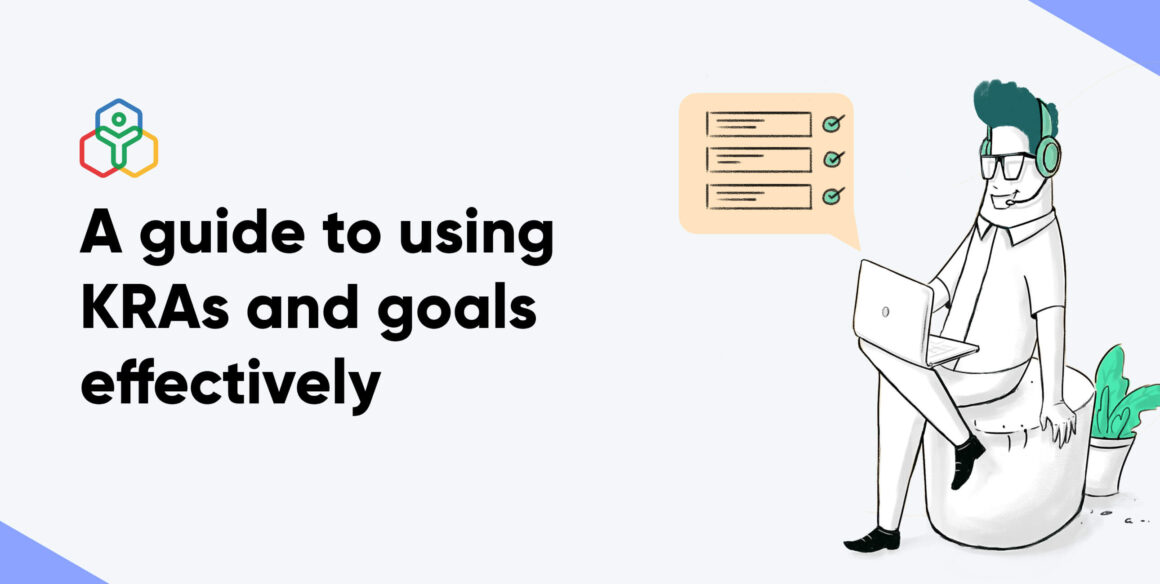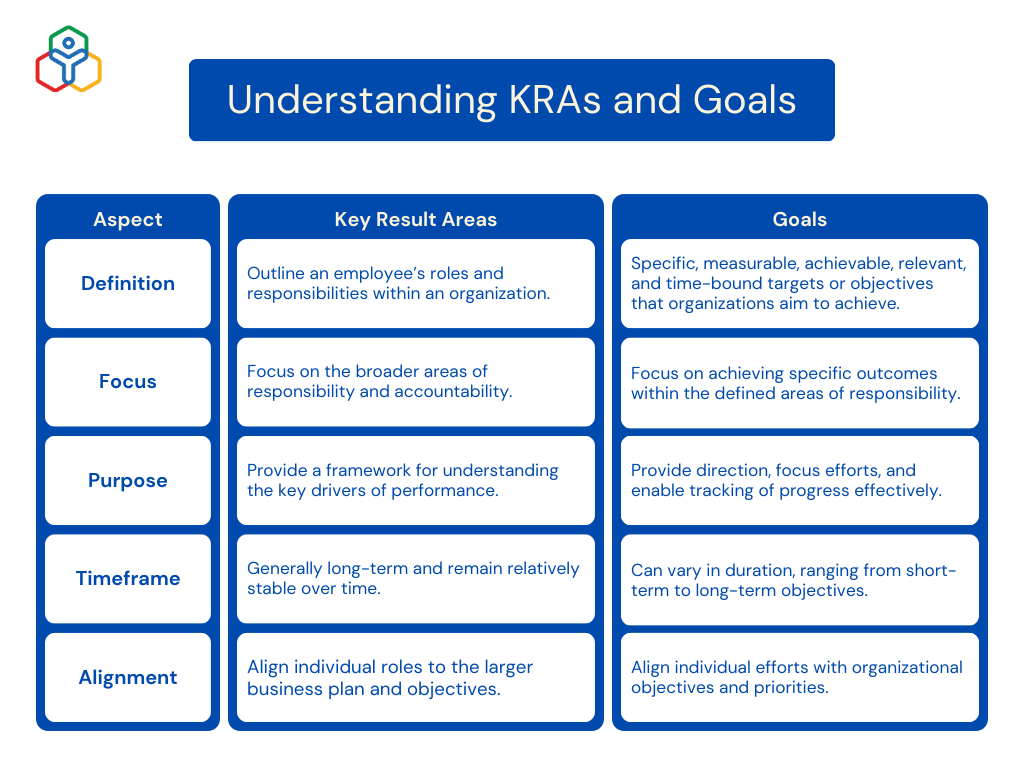- HOME
- More
- HR for SMBs
- KRAs and Goals: A guide to using them effectively
KRAs and Goals: A guide to using them effectively
- Last Updated : March 18, 2024
- 51.9K Views
- 7 Min Read

Ask yourself this: what is the ultimate aim of your business? “To help my customers with the best experience, increase my revenue and grow successfully” would be the most obvious answer. But how do you achieve success without a dedicated and engaged team of employees who know their responsibilities and goals and are aware of how they impact the big picture? This goes far beyond effective talent acquisition strategies—it’s where good performance management strategies come in.
To start with, you need a consistent way to assess and develop employee performance. This is where performance measuring factors like KRAs and goals come into the picture. These performance factors don’t just help you to track the progress of employee performance, but most importantly, they allow you to align individuals’ goals and responsibilities with those of the organization.
A recent Gallup study found that only one in two employees knows what is expected of them at work every day. Simply put, that means that half of your workforce has no clue what they’re doing at work.
So, what exactly are KRAs and goals? How do they help organizations? And where exactly can you start with KRAs and goals? In this blog, we've broken down the basics:
KRAs
Key Result Area/KRAs outline an employee’s roles and responsibilities within their organization. KRAs help individuals align their roles to the larger business plan and focus on results rather than activities. This allows employees to set priority goals and objectives, and make effective decisions.
Goals
Specific: Vague goals can lead to imprecise work. The better you define what you expect to see happen, the greater the chances of achieving exact results.
Measurable: Set goals in a way that produces visible, tangible results. It’s helpful to use metrics that can be quantified.
Achievable: Objectives must be reasonably attainable, taking into account practical obstacles such as time, money, and labor.
Relevant: Goals must be applicable to the employees involved in achieving them.
Time-bound: Setting an end date by which goals can be reasonably achieved motivates employees without pressuring them.

Why use KRAs and goals?
KRAs provides a framework and a clear understanding of the key drivers and outcomes of employee performance, while goals design the path for your employees to achieve the focused key results. KRAs and goals work hand in hand, helping you determine what approach works best for a particular team, analyze how well employees perform and keep track of their work progress. If they’re implemented well, you’ll be amazed by the wealth of insights you can gather about each team and how streamlined your performance assessment can get.
Now that we understand how KRAs and goals can boost employee performance, you probably want to know where to start. Here are a few practical tips that’ll help you get started with KRAs and goals.
Best practices for setting KRAs
1) Look at the big picture
By now you understand that a KRA ultimately boils down to the end results that an individual, team, or organization would like to achieve. To start off, here are a few questions to consider:
- Where was my team a year ago? Where do I want my team to be in the next quarter or the next year?
- Is this aligned with my larger business expectations?
- How do I communicate this to every individual in my team?
- How well can I track individual performance?
2) Set quantitative and qualitative KRAs
Once you know what results you’d like to achieve in the near future, it’s time to choose how you’re going to track and evaluate them. KRAs can be of two types: qualitative and quantitative. Take for example the role of a sales executive. Qualitative KRAs would include areas of expertise like negotiation, team communication, and decision-making, where assessments on a numerical scale are difficult to assign precisely, but still essential. Quantitative KRAs include responsibilities like sales targets in a month or deliverables which can be measured with specific parameters. Decide whether your organization needs to use qualitative or quantitative KRAs, or to strike a balance with both. We suggest a combination of both, which will help you do a more holistic analysis of employee performance.
3) Establishing KRAs
A Gallup report says,
Only 41% of employees feel that their job description aligns well with the work they currently do.
Establishing clear expectations and responsibilities gives a leg up in employee performance and development.
When you craft KRAs, be sure they are:
- Relevant to the individual’s or team’s role and skill sets
- Clearly stated with a definitive timeline and end goal
- Practically attainable, fair, and challenging (around 4 or 5 KRAs for a quarter)
Considering the above points while crafting Key Result Areas will help you, as managers, to track progress, measure outcomes, gain insights, and modify responsibilities to succeed in the future.
Now that you’ve set strategic priorities and results to be achieved, it’s time to orient your employees to achieve the results expected of them.
Best practices for effective goal setting
1) Collaborate with your team
According to a 2021 Gartner Survey, only 9% of organizations involve peers in the goal-setting process and only 15% of organizations involve their entire team. Goal setting goes beyond setting specific, measurable, attainable, relevant, time-bound (SMART) goals, with continuous assessment and coaching. A collaborative process personalizes performance management and builds a good rapport between the manager and the employee. With an increasingly millennial workforce that seeks an active part in decision-making, collaborative goal setting gives employees a voice in setting fair, relevant, and challenging goals.
2) Establishing Goals
According to a recent article from Forbes, lack of clarity in setting expectations is one of the major contributors to workplace anxiety.
Here are a few goal-setting tips to retain your best assets and increase productivity:
- Make it more than an annual goal-setting process. Setting goals frequently has a better impact on employee productivity and achievement.
- Make sure you set SMART goals. Assigning 5 to 10 achievable goals for every KRA per month or quarter can help employees prioritize projects and work on areas that produce the most ROI.
Develop an action plan to help your employees acheive goals by breaking down them into small tasks. As a next step, help them prioritize those tasks and assign all resources required to achieve them.
- Ensure monthly or weekly check-ins happen in order to maintain progress.
- Clearly distinguish between long-term and short-term targets. This way employees will have a better understanding of how their efforts fit into the big picture.
Effective Communication of KRAs and goals
Effective communication enables employees to understand their role and the work they do. It also enables managers to identify areas of improvement and see where and when they need to change their approach towards an employees’ performance. It should drive growth and development and empower employees. Here are some ways to communicate goals and key responsibilities effectively.
1) Onboarding:
Once an employee is selected for a particular role, their natural reaction is to find out what is expected of them and how they can prove their strengths and abilities. Setting the right path with the right expectations and tasks from day one will make employees feel valued and focus their efforts on achieving their performance milestones.
2) Team meetings:
Team meetings are a great way to establish goals and key drivers of success for your entire department so that everyone’s on the same page.
3) 1:1 check-in:
Employees who’ve met their managers in person in the last 6 months are 2.8 times more engaged, says recent research. Individual meetups allow the supervisor and employee to communicate about achievements and drawbacks and provide feedback, and they also ensure transparency in performance expectations and evaluation.
4) Before beginning a project:
Before beginning a new project, it's always good to gather your team and set clear expectations by helping them define the KRAs and the associated goals. This way, employees will know what would be their responsibilities within the project.
5) Use software:
To allocate KRAs and goals, maintain a record of them, and track progress and evaluate them, might all seem overwhelming. You need tools that can scale with your increasing needs. Performance management software will also help managers to be aware of what every employee in their team is working on and assess their performance. It’s not just for managers, either—software with self-service portals can also enable employees to mark their own goals and KRAs. In short, KRA software help managers define, track, manage, and align KRAs and Goals for their teams effectively.
Examples of KRAs and Goals
Here are some examples for effective use of these performance factors.
Example 1: Designation - Client Relationship Manager
KRA: Improve client relations by 10% within 3 months
Goals:
Improve the client satisfaction score measured by surveys by 15%
Introduce better communication channels to stay in touch with clients regularly
Reduce average response time to clients by 20%
Example 2: Designation-Senior Sales Executive
KRA: Increase revenue by 1000 USD in Q1
Goals:
Identify upselling opportunities among customers
Coordinate with marketing team to create targeted marketing campaigns to reach new clients
Provide a limited-time offer during the festive season
Example 3: Designation-Curriculum Developer
KRA: Bring innovation in curriculum design to attain better learning outcomes and improve engagement
Goals:
Introduce gamification in curriculum design to create an interactive learning experience
Introduce practical learning approaches that promote critical thinking
Introduce new ways to help students experience content through Augmented Reality technology
Example 4: Designation-Accountant
KRA: Strategic Budgeting for Q1
Goals:
- Allocate budget, keeping the actual admin expenditures within the budgeted expense ratio
- Complete course on Strategic Budgeting
Final Thoughts
Just as important as setting KRAs and goals is assessing the quality of work, measuring progress, monitoring, refining and giving timely feedback, and offering proper coaching before the employee has gone too far off the mark. Your people can be successful only when they’re led on the right path, their work is recognized, and shortcomings are worked through. Goals and KRAs are a great way to enhance your employees’ performance and prepare your workforce for the future. They also act as a workforce engagement tool through focused coaching and developmental opportunities and an effective optimization tool for using employees’ strengths in the best way possible.
What does Zoho People have to offer?
Zoho People offers a customizable performance management system, where you can assign KRAs, goals, skill sets and competencies and track progress. The customizable appraisals allow you to include these factors to be evaluated by the employees themselves during self-appraisals, or by the managers or multi-raters (if an employee is working on multiple projects). You can also gather insights about your workforce with the 9-box matrix, appraisals, skill sets, and other reports. Using software to monitor and assess performance makes work easier and consistently better for your HR team, managers, and employees.
 Princy
PrincyProduct Marketer at Zoho People.


